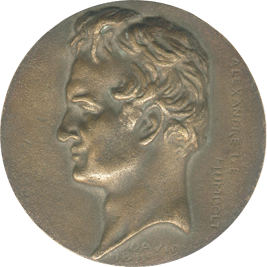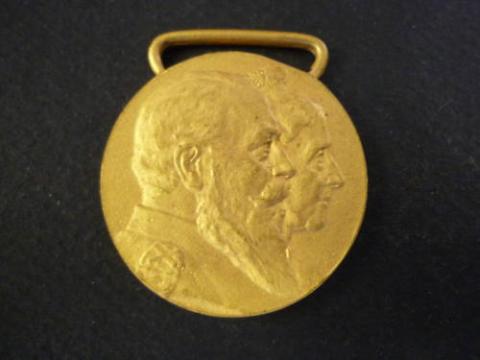Großherzogtum Baden, Friedrich-Luisen-Medaille, verliehen 1906 bis zumindest 1912.
Qualitativ minderwertiger Abguss eines probemäßigen Exemplars, mit unruhiger Oberfläche und zahlreichen Gusslunkern sowie gusstypischem Abbruch vorderseitig auf etwa ein Uhr. Das Relief ist insgesamt so schwach wiedergegeben, dass die Signatur „R.M.“ des Medailleurs Prof. Rudolf Mayer komplett verschwunden ist. Außerdem ist der Medaillendurchmesser mit 36,6 mm zu klein, das geprägte Original misst laut Literaturangaben 38,3 mm. Die Masse fällt mit etwa 27,3 Gramm dementsprechend geringer aus (Literatur: 29,0 Gramm). Der Bügel ist mitgegossen anstelle, wie beim Original, aus einem eingelöteten Draht, zwischen Bügel und Medaillenrand finden sich grobe Feilspuren.
Aus genannten Gründen handelt es sich offensichtlich kein verliehenes Original. Anhand der mäßigen Abbildungsqualität des Verkäufers (Abb. 1) war ich tendenziell von einem Original ausgegangen, eine Einschätzung, die ich nach Erhaltung bereits nach oberflächlicher Betrachtung schnell verwerfen konnte. Ob es sich letztlich um eine authentische Bedarfsfertigung, also ein Zweit- bzw. Schnallenstück, oder um eine moderne Betrugsfertigung bzw. Fälschung handelt, kann nicht mit absoluter Sicherheit festgestellt werden.
Wegen dem mitgegossenen Bügel statt einer für ein Zweitstück viel praktischeren und auch fertigungstechnisch weniger anspruchsvollen Ringöse und vor allem wegen der matten Vergoldung, wie sie für die Originalstücke typisch ist, liegt zumindest der Verdacht nahe, dass das Aussehen eines verliehenen Originals möglichst genau kopiert werden sollte, um einen Käufer zu täuschen.
Erworben auf ebay.fr im Jahr 2010 und seinerzeit dem Verkäufer retourniert.
Die Medaille steht hier nicht zum Verkauf, es handelt sich um einen rein informativen Beitrag!
~ ~ ~ ~ ~ ~ ~ ~ ~ ~
Grand Duchy of Baden, Friedrich-Luisen-Medaille, awarded from 1906 to at least 1912.
Poor-quality cast of an officially struck example with uneven surface, numerous casting blowholes, and typical surface disruption on the obverse at around 1 pm. The relief is reproduced so weakly that the engraver Prof. Rudolf Mayer’s initials, “R.M.,” are completely gone. Also, the medal’s diameter of 36.6 mm is too small; the die-struck original measures 38.3 mm according to the relevant literature. Thus the medal weighs only about 27.3 grams (literature: 29.0 grams). The medal and suspension are cast in one piece, in contrast to the original where the suspension is made of an attached length of wire. There are also traces of rough filing between the suspension and the edge of the medal.
Due to the aforementioned reasons, the medal is clearly not an awarded original. From the low quality image provided by the previous seller (fig. 1) I assumed it was a proper one, an assessment I abandoned immediately upon receiving the medal and taking a quick look at it. Whether the medal is an authentic, old wearer’s copy or a modern forgery, I cannot tell with dead certainty.
The one-piece casting of the suspension (instead of a much simpler to produce ribbon ring that would also make a wearer’s copy easier to mount), and especially the matte gilt (as is typical for originals), raise at least the suspicion that the appearance of an awarded original was copied as accurately as possible in order to deceive a buyer.
Acquired on ebay.fr in 2010, and returned to the seller at the time.
The medal is not for sale here; this is a purely informative post!





